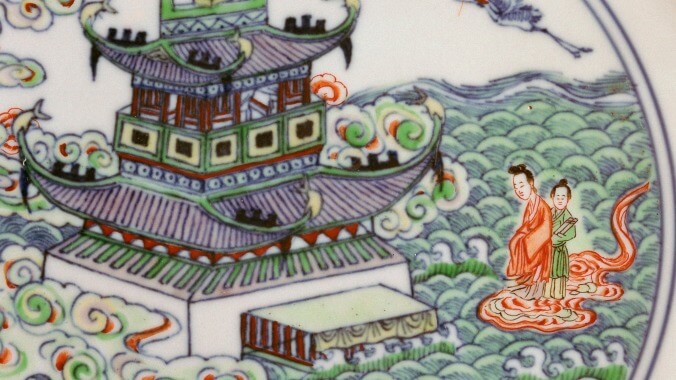China once had such a monopoly on porcelain we just call it “china”


This week’s entry: Porcelain
What it’s about: China. But not the country. The delicate yet strong material that was part of a wave of advancements that reached Europe from the East in the 1500s. Porcelain was so identified with its source that the English-speaking world called it “china,” and it would be centuries before anyone outside of East Asia unlocked its secrets. The material is derived from kaolin, a clay silicate, and can be shaped in great detail, is impermeable to water, and is white, which means it can be easily painted or glazed.
Biggest controversy: Japan couldn’t produce china without kidnapping Koreans. Porcelain was developed over centuries, as the Chinese refined their methods gradually between 2,000 and 1,200 years ago, and once perfected, those methods became a national secret. Japan was a major importer of Chinese porcelain, but was never able to make its own until invading Korea in the 1590s and capturing Korean potters. Korea had better kilns than Japan, Japan had a good source of kaolin, and this forced collaboration led to the first non-Chinese porcelain.
Strangest fact: Europe broke into the porcelain business after a misguided effort to turn lead into gold went awry. Johann Friedrich Böttger was a teenage alchemist, trying to create or discover the fabled philosopher’s stone, which according to legend could cure any disease and turn lead into gold. Word of his efforts reached the ears of Frederick I of Prussia, whose lust for gold is described here as an “insatiable hankering.” He insisted Böttger continue his work in “protective custody,” which we’re pretty sure is a euphemism for captivity.
Böttger escaped, and was promptly captured by a different monarch, Augustus II of Poland, Saxony, and Lithuania. He is also described as having an “insatiable hankering,” and was also broke, giving his hankering some desperate undertones. He imprisoned Böttger in a dungeon, where he spent years inventing “many a noxious concoction,” never quite finding success. A frustrated Augustus paired him with legitimate scientist Ehrenfried Walther von Tschirnhaus, who was himself trying to unlock the secret of manufacturing porcelain. Using kaolin imported from China and locally produced alabaster, the two produced, “hard, white and vitrified European porcelain” in 1708. Two years later, Saxony had the first porcelain factory in Europe, and Böttger had done better than alchemy—his porcelain was worth more than gold.
Thing we were happiest to learn: Porcelain isn’t just valuable as pottery. The material is an excellent insulator for electricity and is used in high-voltage cables, power transformers, and high-frequency antennas. There’s a whole discipline of ceramic engineering devoted to creating porcelain and other ceramics for use in everything from superconductors to artificial bone to the tiles on the Space Shuttle.
Thing we were unhappiest to learn: Böttger and Tschirnhaus’ efforts were ultimately unnecessary. Only four years after their breakthrough, a French Jesuit priest named François Xavier d’Entrecolles pioneered industrial espionage by recording the secrets of porcelain making while on a trip to China and sending them back to Europe. D’Entrecolles became a Jesuit in 1682, at age 18, and in 1698 traveled to China for missionary work. By 1706, he became Superior General of the French Jesuits in China. He had become fascinated by porcelain, and in reading up on it, discovered the secrets of its manufacture, which he promptly sent back home in a letter. He also described Chinese methods for raising silkworms, collecting mercury, and vaccinating against smallpox. His letters were published in France, leading to the Sèvres Manufactory, France’s first porcelain factory. D’Entrecolles himself remained in China until his death in 1741.
Best link to elsewhere on Wikipedia: Another remarkable use for porcelain is the lithophane, a sheet of porcelain so thin as to be translucent, with artwork etched into it. The lithophane is thin enough that the art can only be seen when backlit, but just thick enough that the image can have depth. Lithophanes began to appear in several parts of Europe in the 1820s, but they’re believed to have originated in China a millennia earlier during the Tang Dynasty. Later Ming Dynasty scholars wrote of Tang bowls “as thin as paper” that included secret images.
Further down the Wormhole: The United Kingdom got into the porcelain game relatively late, when kaolin deposits were discovered near Cornwall in the 1760s. As the most popular pre-Wikipedia disambiguation explains, Britain is the island that contains England, Scotland, and Wales; the U.K. unites those three countries and Northern Ireland. Northern Ireland (specifically Belfast) is the birthplace of the doomed RMS Titanic, although the ship sailed from Britain (Southhampton). The iceberg-hitting world’s largest metaphor was the subject of James Cameron’s record-breaking film Titanic, but the very first movie about the ship, Saved From The Titanic, stared Dorothy Gibson, an actress who survived the wreck and barely took the time to dry off before starring in the film, released only a month after the ship sank. We’ll meet Gibson next week.